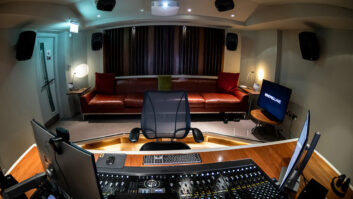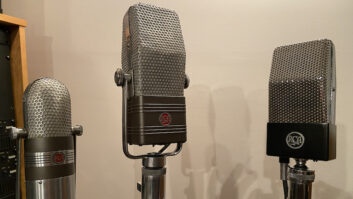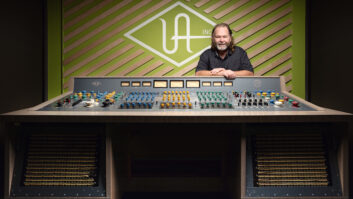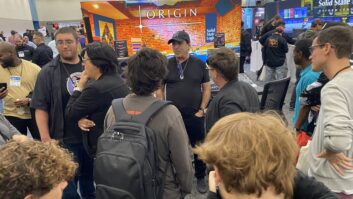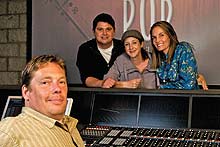
Foreground, Steve Thompson; standing, Doug Clark, Moksha Bruno and Susie Boyajan
Sitting smack-dab in the middle of Santa Monica’s bustling post-house enclave, POP Sound is two audio post-production outfits in one, and each is an industry leader. The home theater division’s regular clientele encompasses most of the major film studios, from Sony to Lion’s Gate, while the commercial division works with a passel of top-line ad agencies.
POP is housed in a two-story structure built in the 1930s and more recently spiffed up in a hybrid style that’s part-Mediterranean and part-industrial. The 17,000-square-foot facility houses 11 mix rooms: six for home theater and five for commercials. The commercial mix rooms are being changed over to Pro Tools/ICON-based mix and editorial systems, with three now in place, while the home theater rooms are moving to a Neve DFC-based platform with a DFC back end. Each of the larger rooms has a perforated screen with theatrical-type, THX-certified drivers, while the small rooms are calibrated using near-field home theater standards and ADAM monitors. There’s also an ADR stage boasting a Euphonix console for dubbing and voice-over projects ranging from feature films to videogames. Each of POP’s mix engineers is experienced in both platforms.
According to operations manager Doug Clark, there’s an ongoing synergy between the two realms. “All these new things that come up in home theater only help the commercial guys from a technical standpoint,” he explains. “When you’re mixing a commercial, somebody else might be mixing The Flying Nun TV series and coming across certain problems, and the solutions they come up with could be applicable to the commercial side: ‘Hey, when you do this in Pro Tools, this happens.’ It’s good to have that expertise working for you across the board.”
Clark leads me into the conference room, where I meet director of home theater Moksha Bruno and technical director Steve Thompson. All three have been working here since the ’90s, Thompson moving over from Dolby Labs, where he helped develop the consumer side of the company’s surround program during the laser-disc era; and Bruno rising all the way from serving coffee to clients to her current executive post. The only person missing from the POP Sound brain trust is executive producer Susie Boyajan, head of the commercial division, who’s away on business.
POP has so many home theater projects that it runs day and night shifts, the bulk of the work involving DVD mastering, encompassing film restoration and multichannel music mixing, with as many as 50 projects running at any one time. It’s in this area that all of the state-of-the-art technology and veteran expertise under this roof take on a vital importance, one that serves art and commerce, as digital technology is used to preserve Hollywood’s vital legacy. Last year, POP spent eight intensive months restoring the audio for The Godfather: The Coppola Restoration DVD Collection, and recently completed 7.1 and 5.1 mixes of the Star Trek movies 1 through 10, as well as a 5.1 remix on the Friday the 13th series.
“A lot of what we’re doing is archeology or detective work,” says Thompson. “We’re trying to reconstruct what they did the first time around, taking advantage of the ability to clean it up and raise the fidelity. But we’re pretty well known for our approach, which is to stay as faithful to the original as possible. So there’s a lot of that kind of scrutiny: listening to the takes for the score and trying to figure out how the whole thing progressed. It also means reading whatever notes are still available — from track sheets to scribbles on the tape boxes — to figure what belongs and what doesn’t.”
“We take elements from the original 35mm print, or the original ¼-inch, 1-inch or 2-inch tape,” Bruno explains. “Sometimes we take music from one element and the dialog from a completely separate element, and then we take the mono mix from another element. Fortunately, our clients trust us and give us what we’re asking for, which is every music element they can find. Don’t send us just one, because that one might be incomplete or it might be shedding or the tape’s disintegrating.”
“What we’re doing is saving these elements,” Thompson adds. “In a lot of cases, if somebody doesn’t do something now, there will be nothing to play back later — it’ll be gone completely.”
I mention that the restoration work POP is doing parallels that of the catalog divisions of the record companies. Clark points out that legendary engineer/producer Bruce Botnick, best known for his work with The Doors, was one of the company’s founders.
What changes do they anticipate are coming in audio post?
“We’re seeing broadcast in general becoming a much wider playing field,” Thompson replies. “In the last five years, we’ve gone from being nearly 100-percent tape-based to a completely tapeless environment. We’re still making shiny discs, but movies are transitioning to digital downloads. What does that mean for sound, how we prepare, what our workflow is and everything else? We’re a service company that works with lots of different clients; everybody has different needs, and juggling those needs versus how we support that internally is a challenge. But we try to rise to that challenge — to choose systems that are flexible, to have various alternatives for people and in some cases be able to understand what they want more than they know what they want.”
“We don’t want to ever have to say, ‘We can’t do that for you,’” adds Bruno. “We don’t want to say no.”
Send L.A. news to Bud Scoppa to
[email protected].


